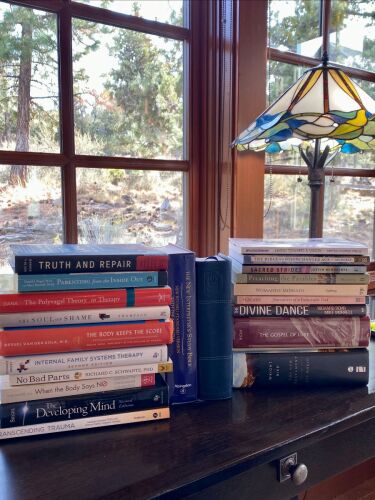
Have you wondered—or heard someone else wonder—if there’s value in revisiting the past?
After all, they say, you can’t change what happened, so why stir things up?
If you are familiar with the internal family members we call protectors, you will probably feel the fear behind this question.
Their job is to avoid vulnerability, and the tender stories in your past are kryptonite to them.
Sometimes, a rationalizing part of you fixates on the logic; indeed, revisiting past events doesn’t change the fact that they happened.
What pure logic misses is that revisiting past events in a healing way can change the meaning a part of you made about what happened.
And that is the heart of healing. When a compassionate witness meets members of your internal family who hold painful burdens—distorted beliefs and distressing emotions—they can share their story and release their burdens. What could be more sacred?
Sometimes, we think “sacred” only applies to stories from the Bible or religious traditions. But the definition includes “regarded with reverence.” When we regard with reverence the stories the most vulnerable members of our internal family hold, they know it is safe to share their shame and grief. They feel seen; their pain is valid.
During the Christma season, we revisit some of the most sacred stories from Scripture.
In the understandable emphasis on joy and glory, we tend to bypass vulnerability, although the text is chock-full of it.
When the angel visits Mary, she is perplexed by being called “favored.” How can completely disrupting her future mean she is “favored”? She rushed off to visit her relative Elizabeth—someone else who was unexpectedly pregnant who could validate the impact of this “blessing.”
Then, just days from giving birth, Mary had to travel over bumpy, dusty roads in response to an edict from the Emperor. She didn’t have a choice about going, and there were no available guest rooms in the homes of friends or extended family. While it’s possible Mary would have women with her to attend Jesus’ birth, it’s also possible they weren’t the ones she would have chosen.
Early in Jesus’ life, Herod goes on a murderous rampage so his family flees to Egypt, grounding Jesus’ history in the history of God’s people who repeatedly experienced exile.
These early stories, along with the rest of Jesus’ life and death center Jesus’ vulnerability. While the protective members of our internal family fear vulnerability and work to avoid it, the Gospels offer another alternative.
What if we shift our perspective to see Jesus’ vulnerability as sacred?
In a culture where political and religious forces buffeted people, Jesus offered another path. He offered a “kingdom” where love is the great power.
Love is inherently vulnerable; we risk loss and pain when we love. Jesus teaches us that we thrive when we embrace vulnerability rather than relying on protective strategies that feel powerful but are a poor substitute for love.
Imagine the vulnerability of the bleeding woman, ostracized for her condition, making her way through the crowd to touch Jesus’ cloak. How did Jesus respond? Did he chastise her for violating religious rules or tell her he was on his way to an important person’s home, so he did not have time for her? No, he invited her to share her story and praised her faith.
Jesus shows us how to connect with the vulnerable members of our internal families—the parts of us exiled for protection.
Offering compassion, curiosity, and connection enables them to trust it is safe to tell us what happened and the meaning they made of their experiences.
It doesn’t erase the experiences; it transforms the meaning they made.
We hold sacred space for them until they recognize their worth. In the presence of Love, they recognize what happened was not their fault because they are unlovable or worthless. They unload anger, powerlessness, grief, and despair. Our most vulnerable internal family members reclaim their belovedness and their agency. They experience wholeness—shalom.
My new book, Journey to Shalom: Finding Healing, Wholeness, and Freedom in Sacred Stories, helps you connect with your sacred stories.
Rediscovering the connection between our story and sacred stories reveals a path to transformative healing in our personal lives.
I can’t wait for you to have this resource!
Dr. Richard Schwartz, the developer of the Internal Family Systems (IFS) model, offered this heartfelt endorsement:
Molly LaCroix’s wonderfully written IFS-based interpretations of biblical stories brings new, uplifting meaning to them and the exercises she offers can expedite our journeys to inner and outer shalom (peace). I’m honored by the depth to which she knows IFS and by the skillful way she uses elements of the Bible to illustrate it. I can strongly recommend this book to observant Christians, to those skeptical of Christianity, as well as those simply wanting more IFS experiences.
Author, therapist, and professor, Dr. Chuck DeGroat, honored me with this endorsement:
Journey to Shalom is an immensely imaginative, psychologically rich, and biblically engaging invitation to embrace our beautiful complexity. Molly’s re-telling of several sacred stories of Scripture humanizes sometimes distant texts and opens them to conversation with our own stories. And the helpful practices and exercises invite us to do our own work. This will be a go-to resource in my clinical work and for my clinical counseling students.
As you reflect on the season’s sacred stories, I hope you will also honor your own.




Leave A Comment